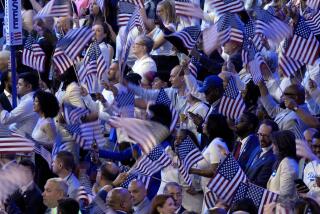Work Is Banner Operation for Employees in Capital
- Share via
WASHINGTON — Hand over hand, William Warley hoists an American flag up a rooftop pole at the U.S. Capitol. It flaps in the breeze for a few seconds and then Warley runs it back down, folds it and boxes it.
Hand over hand--up, then down. Fold. Box. Repeat.
Since the program started in 1937, more than 2.4 million flags have been flown over the Capitol and then sold or given away as souvenirs. Each comes with a certificate marking the date that it flew in the capital breeze--however briefly--and the name of the person for whom it was flown.
“We just send it up, let it blow three or four seconds and then bring it down,” said Warley, one of several workers who together hoist an average of 250 to 300 flags a day except in rain or snow. “This is priority, so if we’re doing another job and emergency [orders for] flags come up, we have to stop what we’re doing and come do this.”
The banner year was 1991 when 154,224 flags were flown. Perhaps Americans were feeling patriotic because of the Persian Gulf War. Nobody knows for sure.
The biggest single day for flag-flying was July 4, 1976, the U.S. bicentennial.
“We did 10,471 that day,” said Christine Benza, who has worked in the flag office for 38 years. “We worked round the clock to make sure all those flags were flown.”
Is it fun?
“Not really,” said Warley, who works on various projects around the Capitol.
Especially not on a day last month when flags around the nation were flying at half-staff to mark the death of former Republican Sen. Barry Goldwater of Arizona. No disrespect to Goldwater, but his death made Warley’s job more difficult.
He had to run each flag all the way to the top, back down halfway in memory of Goldwater, back up to the top and then back down. That’s flag-raising protocol.
“That’s what you’ve got to do,” he said. “That’s my job.”
The flag-waving operation began after a member of Congress asked for one of the flags that had flown over the Capitol and was being replaced because of wear. Word got around.
Soon, the rising number of requests for flags prompted Congress to begin flying smaller flags, furnished by members or constituents, from special poles erected on the Capitol’s roof.
Nowadays, people contact one of their members of Congress to request a flag, sometimes asking that one be flown over the Capitol on a date that marks a special occasion such as a birthday or graduation.
Prices range from $6.94 for a 3-by-5-foot nylon flag to $18.75 for a 5-by-8-foot cotton flag. There are also a $3.30 flag-waving fee and various shipping costs.
In 1995, when Republicans took control of Congress, the House voted to end the flag-waving operation as part of a package of austerity measures. Door-to-door delivery of buckets of ice to 891 House offices also stopped.
The flags kept going up and down the poles: The Senate refused to halt an operation that legislators like because it’s so popular with their constituents.
Instead, the flag-waving operation was transformed from a taxpayer-supported service into a self-sustaining venture. Flag-waving fees cover the cost of running the flag office and paying its six employees.
More to Read
Sign up for Essential California
The most important California stories and recommendations in your inbox every morning.
You may occasionally receive promotional content from the Los Angeles Times.













